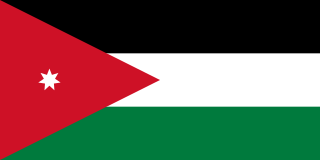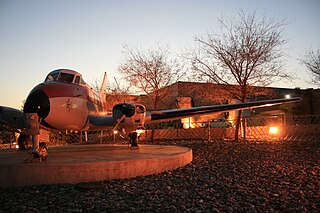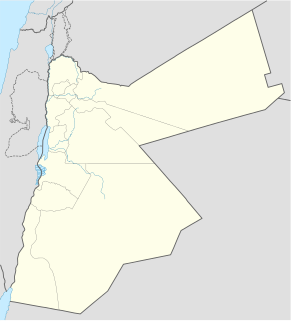
Irbid, known in ancient times as Arabella or Arbela, is the capital and largest city of the Irbid Governorate. It also has the second largest metropolitan population in Jordan after Amman, with a population of around 1,911,600. Irbid is located about 70 kilometres (43 mi) north of Amman on the northern ridge of the Gilead, equidistant from Pella, Beit Ras (Capitolias), and Um Qais, and approximately 20 kilometres (12 mi) south of the Syrian border.

Black September was a conflict fought in Jordan between the Jordanian Armed Forces (JAF), under the leadership of King Hussein, and the Palestine Liberation Organisation (PLO), under the leadership of Yasser Arafat, primarily between 16 and 27 September 1970, with certain actions continuing until 17 July 1971.

Qasr al-Abd is a large Hellenistic palace from the first quarter of the second century B.C.E., whose ruins stand in western Jordan in the valley of Wadi Seer, approximately 17 kilometres west of Amman, close to the village of Iraq al-Amir.

The Jordan University of Science and Technology, often abbreviated JUST, is a comprehensive, state-supported university located on the outskirts of Irbid, at Ar Ramtha in northern Jordan. Since its establishment in 1986, JUST has been at the forefront of institutions of higher learning in the Arab world, it also maintains a high reputation and standard amongst the universities of the Middle East. JUST and the University of Jordan in Amman are considered to be the two premier institutions of higher education for engineering and medicine in the country, although numerous other faculties and specializations are represented as well. The university was described as the best scientific institution in the Kingdom by King Abdullah II during a visit in November 2010. As of the 2006/2007 academic year, JUST had 717 faculty members, with 20,000 undergraduate and 1559 graduate students, in contrast to 2,300 students in the 1986/1987 academic year. At the present time, the university comprises 12 faculties and 55 departments providing 52 bachelor's degree and 95 postgraduate programs. JUST comprised 5,415 international students of 61 nationalities in the academic year 2009/2010, rendering it the most cultural-diverse university in Jordan. It was ranked as the top research university in the country, and amongst the top 3% of universities in the Islamic world, according to a study carried out by the Statistical, Economic and Social Research and Training Center for Islamic Countries (SESRTCIC).
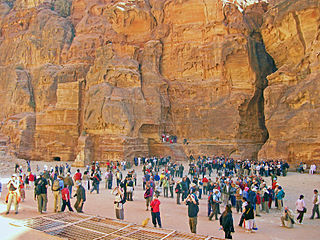
Jordan, officially The Hashemite Kingdom of Jordan, is a sovereign Arab state in the Middle East. Jordan is bordered by Saudi Arabia to the south, Iraq to the north-east, Syria to the north, Israel and Palestine to the west. Jordan is strategically located at the crossroads of Asia, Africa and Europe. The capital, Amman, is Jordan's most populous city as well as the country's economic, political and cultural centre.

Jubaiha is district number 18 out of 27. Located in western Amman, Jordan. It is divided into seven neighborhoods, Al-Jam'a, Al-Rasheed, Qutneh, Al-Sadeeq, Al-Zaytooneh, and Al-Baladiya.

The Umayyad desert castles, of which the desert castles of Jordan represent a prominent part, are fortified palaces or castles in what was the then Umayyad province of Bilad ash-Sham. Most Umayyad "desert castles" are scattered over the semi-arid regions of north-eastern Jordan, with several more in Syria, Israel and the West Bank (Palestine).

The Cultural Center Historic District is a historic district located in Midtown Detroit, Michigan, which includes the Art Center : the Detroit Public Library, the Detroit Institute of Arts, and the Horace H. Rackham Education Memorial Building were listed on the National Register of Historic Places in 1983. The district contains several cultural attractions.
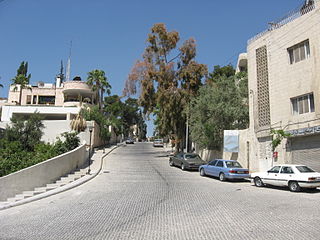
The Rainbow Street, originally named Abu Bakr al Siddiq street, is a public space in the historic area of Jabal Amman, near the center of downtown Amman, Jordan. The street runs east from the First Circle to Mango Street, and contains several attractions from roof top restaurants to pubs. The street runs in front of the British Council building, as well as the headquarters of the Jordan Petroleum Refinery Company and the cinema after which the street is renamed.
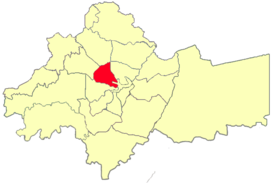
Al-Abdali is the 9th district in the Amman Governorate out of the 27 districts, it is named relative to King Abdullah I who founded it during the 1940s. It covers an area of 15 square kilometres (6 sq mi) in the heart of Amman, with a population of 165,333 in 2015. Large parts of the district are residential, but due its geographical location in the center of the city, it contains several important governmental buildings and businesses. The area is known for containing several bus stations serving routes to many cities in Jordan.

Al Qastal is a town in the Amman Governorate of northern Jordan. Originally established as an Umayyad settlement, it remains the oldest and most complete such settlement in the Near East The remains of the minaret at Qastal is especially important as it is the only one extant from the Umayyad period, making it one of the oldest minarets in the world. Qasr Al Qastal, also located within the town, is considered one of the desert castles and is just 5 km from Qasr Mshatta.
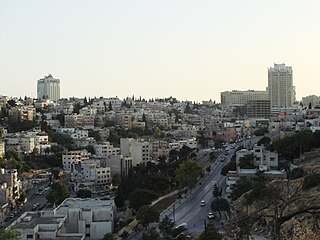
(Jabal, Jabel, Jebel may refer to a mountain or a hill, in Arabic Language.)

The Children's Museum Jordan is a children's museum in Amman, Jordan. It is located in Al Hussein Public Parks.
Omar Maani is a businessman and reform driven politician serving in the house of senate. Mr. Maani also served as Mayor of Amman, the capital of Jordan, for five years from 2006. Prior to his tenure, he was the founder and Chairman of Maani Group, a private sector manufacturing group which he led for the past 30 years. In 27/9/2016 he was appointed as a member of The Jordanian Senate.

Consolidated Consultants (CC) is an international architectural and engineering consultancy firm, specialized in the provision of studies, planning, design and management services in architecture, buildings, infrastructure, transportation, roads, bridges, water and waste water, dams, hydrological analysis and hydraulic structures, with over 600 staff operating in more than 25 countries.
The Prophet Muhammad Museum is a museum about the Prophet Muhammad in Amman, Jordan. The museum was opened on 15 May 2012 at the King Hussein Mosque in Al Hussein Public Parks in Amman, with King Abdullah II of Jordan officiating.
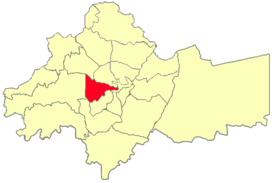
Zahran is the 8th district in the Amman Governorate out of the 27 districts, named after Zahran Palace which stands amidst Zahran street. It consists of 5 neighborhoods of which most parts are residential, however, some parts of the district contain Amman's best hotels, hospitals and towers. The district is also home to several governmental buildings, embassies, cultural centers and schools. Zahran district stretches from 1st circle to between 5th and 6th circles, and from North Abdoun to South Abdoun.

The Architecture of Jordan has been subject to vast development specifically in the final years of the twentieth century. Jordan is a small country located in the Middle East. Its location has extreme significance to Christians, Muslims and Jews as it is considered part of the Holy Land. The traditional architecture in Jordan can be attributed to many factors which have played a pivotal role in shaping Jordanian culture. These factors include the different groups of people who have lived in the land, the mostly arid desert climate and the terrain which is dominated by the Jordan River Valley, the Dead Sea and the Jordanian Highlands. As a result of increased urbanisation and an open approach to global architectural trends, Jordanian architecture began to neutralise the traditional forms of architecture that dominated the region.


